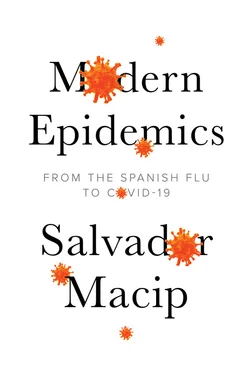In 2005, a group of scientists, including Adolfo García-Sastre, a Spanish virologist working at the Mount Sinai Hospital, New York, managed to read the genome sequence of the virus that caused the 1918 flu pandemic. The biological material was taken from a well-conserved frozen corpse found in the glaciers of Alaska. The genetic information they obtained allowed them to re-create the virus in the laboratory and, with this synthetic virus, to reproduce the lethal effects of the infection in mice. The aim was to understand how the 1918 virus functioned and why it had been so deadly, in the hope of being able to design better drugs and vaccines against future pandemics.
With these experiments, for example, it was possible to confirm that this virus multiplied 40,000 times faster under laboratory conditions than the ones we see today. Prior to this, there were two nonexclusive theories to explain why the pandemic had been so devastating. One was that the virus had been more aggressive than other strains, and the new results demonstrated that this was so. The second was that there was a special predisposition in the population – and not only due to problems deriving from the war – which included malnutrition and poor public health facilities. But this possible susceptibility is hard to demonstrate, as there isn’t enough material conserved for carrying out studies.
The work of Dr García-Sastre and his colleagues aroused the fears of both citizens and other scientists who believed that it would be dangerous to ‘resuscitate’ such a terrible virus. Others believed that the chances of the new virus escaping weren’t very high, while the authors of the study argued that the benefits greatly outweighed the possible risks. Naturally, the safety measures around people handling these kinds of microbes are exhaustive, and accidents are therefore unlikely. Moreover, it’s believed that today’s population has more immunity to the virus than people did in 1918 because, since then, the circulation of variants similar enough to the original one might have generated a certain response that could protect us. The virus has been studied ever since that time without any notable incident.
Smallpox, a disease of the past
There is only one microbe causing diseases in humans that we have managed to eradicate from the planet. This sole example, so far, is the virus responsible for smallpox, a disease characterized by a generalized rash with fever and which, in serious cases, can have a mortality rate of between 20 and 60 per cent. It also has numerous sequelae, including blindness. It is believed that, throughout history, the smallpox virus has killed more humans than any other, and not only in ancient times. In the eighteenth century, 400,000 Europeans died of smallpox every year and, in the twentieth century, it killed between 300 and 500 million people worldwide. In 1967 alone, it infected up to 15 million people, according to a World Health Organization (WHO) report.
The success in terms of healthcare has been due to vaccination campaigns which, as I will explain below, began in the nineteenth century. The last smallpox patient was registered in the United States in 1949, while the world’s last natural infection was seen in Somalia, in 1977. Vaccinations which, in themselves, could give rise to small outbreaks of smallpox, ceased to be given not long afterwards. In May 1980, the 33rd World Health Assembly officially declared the world free of smallpox.
Poliomyelitis: next on the list?
Poliomyelitis, more simply known as polio, is a disease that causes paralysis in 1 per cent of those afflicted by it because the virus responsible destroys nerves. The most frequent kind is paralysis of the legs, but if the nerves controlling the muscles related with breathing are affected, it can be fatal. Some kinds of paralysis reverse in the first year but, after that time, few improve. It’s calculated that, at the beginning of the twenty-first century, between 10 and 20 million people had survived polio, with varying degrees of sequelae. In 90 per cent of cases there are no symptoms.
The disease was discovered in 1840 and the virus that causes it, the poliovirus, in 1908. It’s mainly contracted through water contaminated with faeces of infected people (where the virus can live for weeks), although saliva can also be a source of transmission. The number of cases of polio increased spectacularly at the beginning of the twentieth century, which spurred on the quest to find a vaccine. Jonas Salk achieved the first (1952) and Albert Sabin the second (1962). In 1988, there were 350,000 cases of polio in the world. It was initially expected that the disease would be eradicated by 2000, but that didn’t happen. In 2007, there were 1,315 cases recorded and, in 2008, another 1,643; despite everything, this was a remarkable decline in just twenty years. The year with the fewest cases was 2001: just 483 were recorded. Progress seems to have stalled a little since then.
Since the turn of the century, $6,000 million have been spent on preventing and controlling polio. In early 2009, a new initiative was announced to eliminate it from the few places where it still exists (especially Nigeria, India, Afghanistan and Pakistan) and thereby to make it history’s second eradicated disease. An investment of $630 million was made, donated by the Bill & Melinda Gates Foundation, Rotary International groups and the governments of Germany and the United Kingdom, which was distributed by the Global Polio Eradication Initiative (GPEI), part of the WHO. The strategy was mainly to increase vaccination of small children, as this is the most effective preventative. Although the hoped-for results haven’t yet been completely achieved, the experts are optimistic and believe that there is every chance that polio will end up disappearing altogether.
Of the three existing variants of poliovirus, type 1 is the most aggressive. In 1999, type 2 was eradicated. Only a few samples were kept for study or continued production of vaccines. This might have been recorded as the second microorganism to be eliminated from the planet if it weren’t for the fact that, in 2005, it made a surprise reappearance in the middle of Africa. By 2008, it had resulted in thirty cases of paralysis and, by the middle of 2009, a further hundred, together with the possibility that it would start spreading to other areas. The origin of these new outbreaks was the vaccine that was supposed to eliminate it.
Titbits: famous people with polio
Here are some of the famous people who suffered from poliomyelitis. Many of them survived without visible sequelae:
Alan Alda
Francis Ford Coppola
Donovan
Mia Farrow
Frida Kahlo
Joni Mitchell
Doc Pomus
Donald Sutherland
Arthur C. Clarke
Joe Dante
Ian Dury
Mel Ferrer
Jack Niklaus
Itzhak Perlman
Walter Scott
Neil Young
The most famous polio patient in history, the president of the United States, Franklin D. Roosevelt, was most probably confined to a wheelchair because of another disorder, the Guillain-Barré Syndrome.
This happens because the vaccine that is presently being used is the so-called OPV (oral polio vaccine), the one discovered by Sabin. It is very effective. The problem is that it’s made from attenuated viruses and it’s known that, in some cases, they revert to their active form, recover their aggressiveness and cause spontaneous outbreaks. Although it is relatively rare (seen in just one case among almost 8 million vaccinated people), this is precisely what occurred in 2005 with the vaccine against the type 2 virus. In 2009, there were 124 cases of paralysis in Nigeria caused by this vaccine.
Читать дальше












